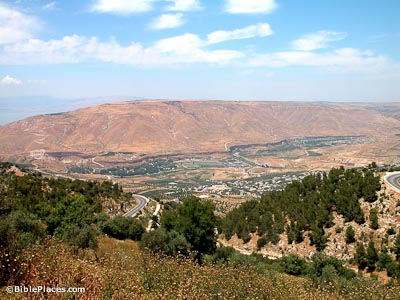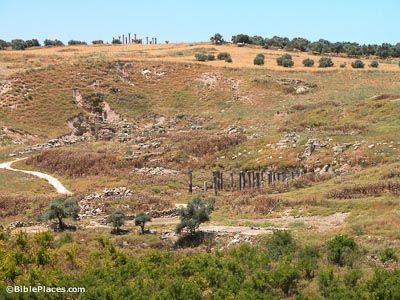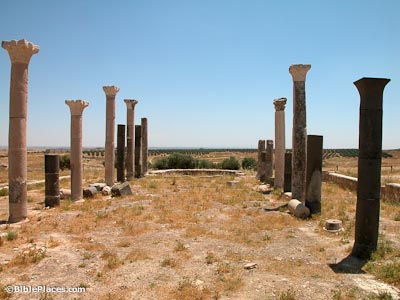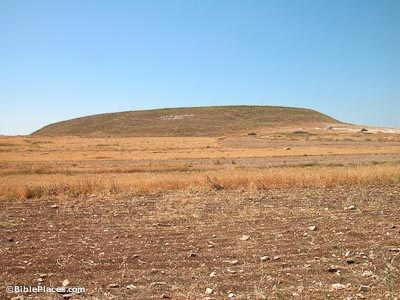The Yarmuk River is the northern border of Gilead and the southern border of Bashan (modern Golan Heights). The Yarmuk is never mentioned by name in Scripture. In the bottom of the valley, on the border of Israel and Jordan, is Hammath Gader, a region of hot springs (hammath) in the district of Gadara. These baths were built and visitors flocked to the site in the Roman and Byzantine periods.
Lower Gilead

Yarmuk Valley
Abila
The modern name of Quailibah preserves the ancient name of Abila. Locals remembered the tell as “Abil” in the 19th century. Abila is one of the cities of the Decapolis (Matt 4:25), but is not referred to specifically in Scripture. The site is divided into two major tells—Abila to the north and Umm el-Amad to the south.


Abila Church
Abila was excavated by W. Harold Mare of Covenant Seminary since 1980. Abila has evidence of occupation from the Early Bronze Age (3rd millennium) through the Umayyad periods (8th century AD), but the most significant remains date to the later periods (Byzantine and Umayyad). Three Byzantine churches have been uncovered at Abila, leading the excavator to suggest that the city was the site of a bishopric headquarters.
Ramoth Gilead
Ramoth Gilead was one of three cities of refuge in Transjordan (with Bezer and Golan). In the Israel-Syrian wars, Ahab fought at Ramoth Gilead and was mortally wounded (1 Kgs 22:1-40). Ahab’s son Joram continued the battle and was wounded as well (2 Kgs 8:28-29). While continuing the battle against Syria, Jehu was anointed king of Israel at Ramoth Gilead. He drove “like a madman” from Ramoth Gilead to Jezreel (2 Kgs 9:14-16). In spite of Israel’s efforts, Hazael of Syria (in Jehu’s time) conquered Bashan (Golan) and Gilead, as far as the Arnon River (2 Kgs 10:32-33).


Tell el-Husn
Ramoth Gilead has been identified with three sites in close proximity to each other. Tell er-Rumeith (pictured above) was excavated by Paul Lapp in the 1960s and has Iron Age remains. Some scholars feel that the site is too small to fit the biblical description. Tell el-Husn (pictured left) is another possibility, though the Muslim cemetery on top prevents excavation. A third candidate is er-Ramtha, but the modern city sits on top of this site and makes excavation impossible.

Download all of our Jordan photos!
$34.00 $49.99 FREE SHIPPING
Related Websites
See also Upper Gilead.
Abila Archaeological Project (John Brown University) The official home of a dig led by the late Dr. Harold Mare, containing a good summary of the history of the site, a site map, discoveries and a few pictures.
Abila: a Neglected Treasury (Paths of Jordan) Quite an extensive look, with many photos, at Abila and all the related archaeology.
Yarmuk River (Britannica) A good encyclopedia introduction to the region.
The Mouth of the Yarmuk Gorge at its Junction with the Valley of Jordan (Australian War Memorial) A 1919 painting of where the Yarmuk feeds into the Jordan River Valley.
Ramoth-Gilead (Jewish Encyclopedia) Brief location profile along with historical and biblical significance.
A Balm in Gilead – Your Solution is Nearer than You Imagine (Wayne Stiles) An encouraging article looking at the geography of the region of Gilead and Jeremiah 8:22, including several photos and maps.
Tell er-Rumeith in Northern Jordan: Some Archaeological and Historical Observation (Academia.edu) For those very interested, this is an academic article looking at one proposed location for Ramoth Gilead. You may also enjoy this 2013 article by Finkelstein, Lipschits, and Sergi.